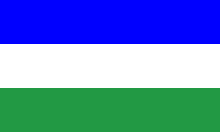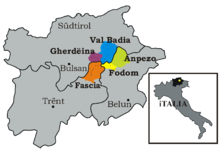 | |
 The Ladin-speaking valleys of Val di Fassa, Val Gardena, Val Badia, Livinallongo and Ampezzo and their locations in northern Italy | |
| Total population | |
|---|---|
| ≈31,000 (2011, est.) | |
| Regions with significant populations | |
| Ladinia | |
| Languages | |
| Ladin | |
| Religion | |
| Roman Catholicism | |
| Related ethnic groups | |
| Friulians, Romansh |
The Ladins are an ethnolinguistic group[1][2] in northern Italy. They are distributed in several valleys, collectively known as Ladinia. These include the valleys of Badia and Gherdëina in South Tyrol, of Fassa in the Trentino, and Livinallongo (also known as Buchenstein or Fodom) and Ampezzo in the Province of Belluno.[3] Their native language is Ladin, a Rhaeto-Romance language related to the Swiss Romansh and Friulian languages.[4] They are part of Tyrol, with which they share culture, history, traditions, environment, and architecture.
Ladins developed a formal national identity in the 19th century.[3][5] Micurà de Rü undertook the first attempt to develop a written form of the Ladin language. Nowadays, Ladin culture is promoted by the government-sponsored cultural institute Istitut Ladin Micurà de Rü in the South Tyrolean municipality of San Martin de Tor. There is also a Ladin museum in the same municipality. The Ladins of Trentino and Belluno have their own cultural institutes, Majon de Fascegn in Vigo di Fassa, Cesa de Jan in Colle Santa Lucia, and Istituto Ladin de la Dolomites in Borca di Cadore.
The Ladin people constitute only 4.53% of the population of South Tyrol.[6] Many of the South Tyrolean Sagas come from the Ladin territory, including the national epic of the Ladin people, the saga of the Kingdom of Fanes. Another figure from Ladin mythology is the demon Anguana.
- ^ Jan Markusse: The South Tyrolese Inter-Ethnic Package Deal. An Example for Other Multi-Ethnic Regions?, in: Yearbook of European Studies 6. Borders and Territories. Rodopi, Amsterdam/Atlanta 1993, ISBN 90-5183-506-X, p. 193-220. E. g. For the small ethnic group of Ladins the package offers advantages and disadvantages.
- ^ Christoph Perathoner: Die Dolomitenladiner 1848–1918: ethnisches Bewusstsein und politische Partizipation. Folio, Bozen/Wien 1998, ISBN 978-3852560809
- ^ a b Sakalis, Alex (22 November 2021). "Italy's Most Mysterious Region Has Warrior Princesses and a Marmot Obsession". The Daily Beast. Retrieved 10 October 2023.
- ^ [1][permanent dead link] "die drei rätoromanischen Teilgruppen (Bündnerromanisch, Dolomitenladinisch, Friaulisch) ... treten als eine vom Oberitalienischen gänzlich differenzierte Sprachfamilie auf" (the 3 reto-romance language-groups Rumanc, Dolomite Ladin and Friulan are a separate language-family from northern-Italian), 2003 by Prof. Dr. Roland Bauer, University of Salzburg
- ^ Christoph Perathoner: Die Dolomitenladiner 1848–1918: ethnisches Bewusstsein und politische Partizipation. Folio, Bozen/Wien 1998, ISBN 978-3852560809
- ^ "South Tyrol in Figures" (PDF). Declaration of language group affiliation – Population Census 2011. Retrieved 2012-10-07.